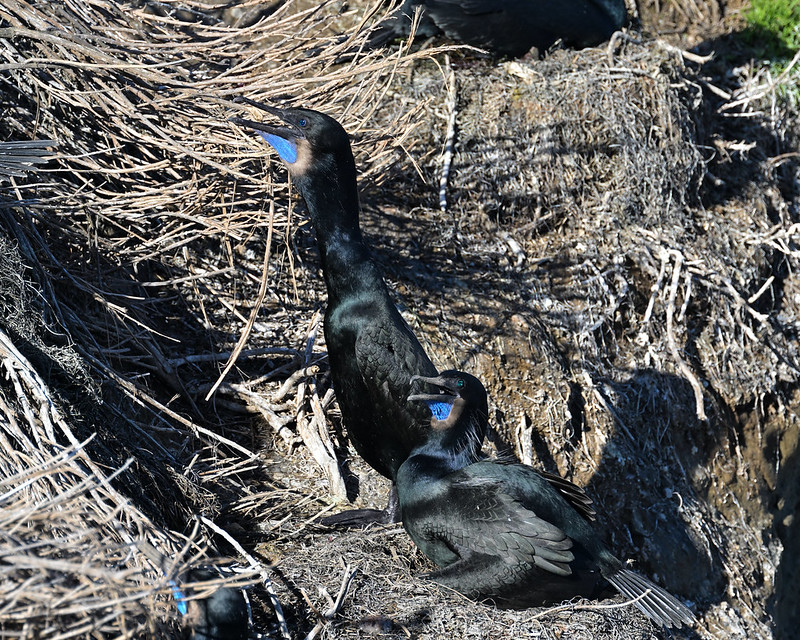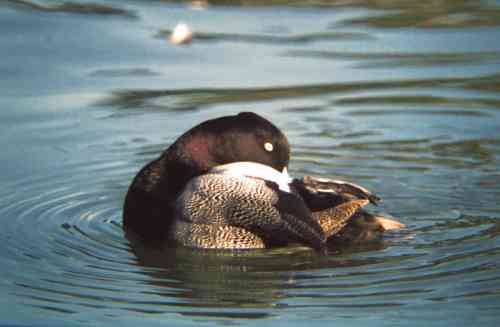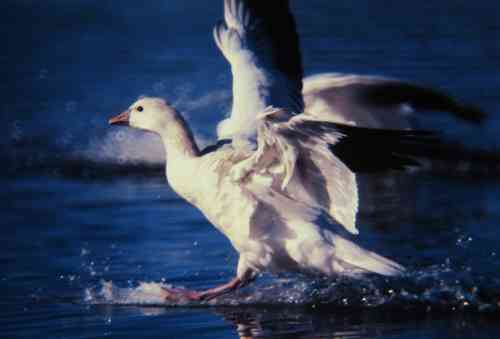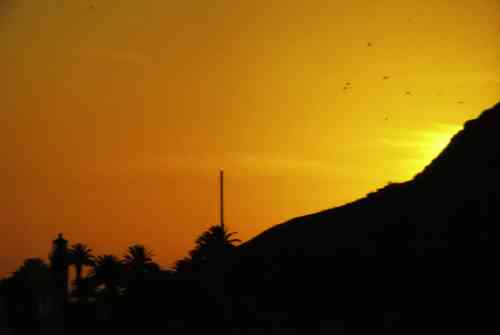Friday Night Photos Breeding Season Blues Editiion
Submitted by Socialprogressive on Fri, 02/10/2023 - 5:00pm

Happy Friday everyone. Hope everybody is doing well. Post any photos, memes, or music you like.
It's breeding season for the Brandt's Cormorant.
The largest cormorant on the Pacific Coast, Brandt’s Cormorant is an expert diver that can swim deeper than 200 feet in pursuit of fish and shellfish. In addition to standard cormorant black, Brandt’s sports a vivid cobalt-blue throat patch and eyes during breeding season, along with wispy white feathers on the head. This species nests on cliffs and forages in the California Current, an area of rich upwelling between British Columbia, Canada, and Baja California, Mexico.








Comments
Cormorants have always fascinated me
they dive down and come back up about 20 minutes later in a place about
100 yards distant. Then, when they surface and get on a rock,
they spread their wings to dry out for a long time.
Like loons, they are built not so much to float, but to dive.
thanks for your pix!
Zionism is a social disease
Hi, QMS.
The Cormorants don't have an oil coating on their feathers that repels water so they extend their wings to dry out in the sun.
MAGA
Morons
Are
Governing
America
Hey QMS!
great pic Q! That is a Double-crested Cormorant. The most widespread abundant one across America. There have been culls to depopulate them I think in Canada, due to pressure from Great Lakes fishing industry. Man building thousands of reservoirs all over America has been great for them and Canada Goose in particular.
The deal with cormorants (and Anhinga) is that they lack a preen gland. This is the gland that is on the rump right above the base of the tail of a bird. Birds get oil from the preen gland on its bill, and then preens its feathers. Thereby waterproofing its feathers. Cormorants lack a preen gland, and then the waterproofing. So they become waterlogged. And have to hang out to dry like so much laundry before they can fly again. Same with Anhinga.
Neat birds, on the prehistoric side I might say...
be well brother!
We cannot solve our problems with the same thinking we used when we created them.
Look deep into nature, and then you will understand everything better.
both - Albert Einstein
Hi Social
What an expression of joy the third photo of the Cormorant is. Also loved the music. The blues rule!
I hope the first blooms of my favourite flower is a positive sign of what is to come. It’s blowing strongly at the moment, and I’m praying that the cyclone heading here is more benevolent than predicted.
This little guy came in today for safety from the storm. It's the first time I've seen one inside.
Be well all
Hey J!
Hi Janis, Hope you are doin' well!
GREAT flower photo... What type? It looks Plumeria-ish but leaves don't look right... a ginger?
That is an oddly shaped head on that lizard. Any idea on type? Looks mighty foreign to me.
Yale Climate has an article up that has some great kiwi data of interest... sounds scary on Monday... haven't checked comment section since yesterday eve, but that is usually where latest prognostications are best... The animation has the North Is. looking like a magnet for Gabrielle.
https://yaleclimateconnections.org/2023/02/auckland-just-had-its-wettest...
Be well and be safe.
We cannot solve our problems with the same thinking we used when we created them.
Look deep into nature, and then you will understand everything better.
both - Albert Einstein
Hi dystopian!
You're right, it's white ginger.
The oddly-shaped head of the lizard is a Skink.
Thank you very much for the yale climate connection, and the fundamental information it includes.
I'll try to keep in touch from my little local perspective.
Thank you for being there.
Hi Janis
wow, a skink? It must be a pregnant female it is soooo fat. Probably has some young in there. Our skinks are generally very slim and slender of shape, and shiny of scales. But you can tell pregnant females, they look like this one. neat beast!
We cannot solve our problems with the same thinking we used when we created them.
Look deep into nature, and then you will understand everything better.
both - Albert Einstein
I thought the same
She must be pregnant. The many I've seen outdoors are generally very slim. I've never seen more than I have the past year, which I'm assuming has to do with all the moist soil. They must love this environment. I hope I don't end up wishing I was a skink ; ).
So far the weather forecast has been pretty accurate. The heavier rains and winds are predicted to increase around now and to be quite intense 24 hours from now. If so I will have another sleepover at my neighbours tomorrow. I'm taking care the best way I know how to, and hoping the landslip has already released all its load and remains stable.
Hi again dystopian
The first Plumeria blossom, in a planter pot looks like it will burst open tomorrow, or the day after. As Auckland becomes increasingly tropical, soon the plumeria can go directly in the ground.
I don’t know what kind of sign this may be, but it is the first dead silvereye I have found. It must have been blown against the house within the past hour. It is the smallest bird that is common here beside the smaller grey warbler. Now I have both the shining cuckoo who takes over the grey warbler nest, and the silvereye in the freezer. Oh, dear.
Hi again J
OMG, bummer on the bird strikes! I would contact a local museum and ask if they are interested in the specimens. The Silvereye maybe not, but probably on the cuckoo. They might make study skins out of them. So they can still be useful. Since bird collecting has gone out of favor, building collisions are one of the main sources of specimens for many museums. If they are hitting windows, that can be hard to fix. They make hawk silohuettes that birds seem to key in on and it seems to help. Making the windows less reflective so they don't look like the 'outside' continues there helps deter strikes as well. Sorry about your birds. I have had freezers full of birds. Once the first and only CA state record of Buff-collared Nightjar spent a night in my freezer on the way to the museum.
We cannot solve our problems with the same thinking we used when we created them.
Look deep into nature, and then you will understand everything better.
both - Albert Einstein
I feel like my freezer is a museum of sorts ; )
I've kept the shining cuckoo for 10 years and occasionally exhibit it to guests. It has kept its gorgeous green iridescence and brown and white breast pattens perfectly. It's a pleasure to look at still. Now it has company.
I hang twirling things in front of the large windows which helps. The cuckoo knocked itself out against a small window, and is the only bird to do so. I read that they are quite vulnerable to doing that.
Hi, Janis
I don't know what type of flower that is but it's very pretty.
I hope you and the little guy who came in from the storm stay safe from the cyclone. I'm keeping my fingers crossed it's less severe than predicted.
MAGA
Morons
Are
Governing
America
Hi pixelators
Hi all, Hey SP! Hope its all good out there!
SP, your Brandt's Cormorant photos are outstanding! Whaddabird! Lots of the jetties and breakwaters in CA have them, and now is the time to see them, when that cobalt blue is at its brightest. The fine hairlike white feathers that are briefly acquired during breeding season are called filoplumes. Double-crested gets some nice ones on sides of head. Are these nesting on Pt. Loma?
Interesting is though the Pelagic Cormorant is named for the sea, pelagic means 'of the sea', the Brandt's Cormorant is far more pelagic. The Pelagic should have been called the Littoral Cormorant, as it is always fairly near shore. Whereas if I see a big flock of Corms 10-20 miles offshore, I know it was going to be Brandt's. In winter off LA Co. I have seen single flocks of 2000 Brandt's 10 miles out at sea. About 9 miles further out than you ever get a Pelagic Cormorant. You should have those there too. They get some nice white patches on the flanks at breeding season.
Fantastic photos SP! Thanks!
I'll drop a couple pix in a few...
We cannot solve our problems with the same thinking we used when we created them.
Look deep into nature, and then you will understand everything better.
both - Albert Einstein
Hi, dystopian
I just learned a new word, filoplumes. Thanks, dystopian. I see the Double-crested Cormorants at Santee lakes a lot during the winter but I haven't been fortunate enough to see them with filoplumes.
These photos were shot at La Jolla Cove. There's some cliff faces at the south end of the cove they like to nest on.
MAGA
Morons
Are
Governing
America
Hi pixelators
Hi all, me again, sorry about that...
I have begun to try to learn how to take digital photos of my slides. Not working very well so far frankly but have converted a couple at least to only a small amount of detriment and degradtion.
Lesser Scaup, male. Alondra Pk., which might be Torrance (L.A.), now is called El Camino Village.

Ross's Goose, skiing at Harbor Pk. in L.A.

Pt. Vicente sunset, about Sept. 1994, specks at upper right are indeed birds. Pt. Vicente is on the Palos Verdes Peninsula, the bump sticking seaward at the SW corner of mainland L.A. County.

Will work on figuring this out ...
Be well all!
We cannot solve our problems with the same thinking we used when we created them.
Look deep into nature, and then you will understand everything better.
both - Albert Einstein
The Lesser Scaup
looks perfectly comfortable in its concentric circles. Thank you for the images.
Nice shots, dystopian
I really like the gold tones in the sky in the last photo.
You might want to look into using a flatbed scanner for converting your slides to digital. There are also businesses that will convert them for you.
MAGA
Morons
Are
Governing
America
I love the action
captured in the goose photo. It's very dynamic.
Thanks Janis!
Thanks Janis. I have a 20" x 30" poster of that pic somewhere that was on the wall back in L.A., the goose is dang near life-sized. Guess I was kinda fond of it ...
We cannot solve our problems with the same thinking we used when we created them.
Look deep into nature, and then you will understand everything better.
both - Albert Einstein
The more I look at the goose photo
the more surreal it looks. It's very alive, even though it's a photo.
Great images--SOP.
My late mother always called Cormorants "snake birds." I'm not a birder so I don't know why. We've got them all over the place here in the gradually sinking Sandbar Peninsula.
 Good luck weather-wise, janis. I have YCC bookmarked. It is a go-to site during storm season. Ugh! Anyway, Rec'd!!
Good luck weather-wise, janis. I have YCC bookmarked. It is a go-to site during storm season. Ugh! Anyway, Rec'd!!
Inner and Outer Space: the Final Frontiers.
Snake-bird
Hey OBF! For quite a long time, a hundred years or more, one of the commonly used colloquial names used for Anhinga, is Snake-bird. Anhinga is shaped similar to a cormorant, and has to hang out to dry like them. And is most abundant in FL. So often cormorants got lumped with Snake-birds, when it came to names. The Anhinga often swims with its whole body underwater though, so only the neck and bill stick up and out of the water. Looking allegedly like a snake due to their longer thinner neck. They are everywhere in FL. Anhinga is in a different family than cormorants, note its dagger bill shape compared to the hook-tipped thick cormorant bill.
We cannot solve our problems with the same thinking we used when we created them.
Look deep into nature, and then you will understand everything better.
both - Albert Einstein
Snake Bird is common name of the Anhinga, a near
look alike diving bird from back your way.
be well and have a good one
That, in its essence, is fascism--ownership of government by an individual, by a group, or by any other controlling private power. -- Franklin D. Roosevelt --
Thank you obf
I've spent lots of time in Florida, so I know you can relate. I'm glad to know of the YCC.